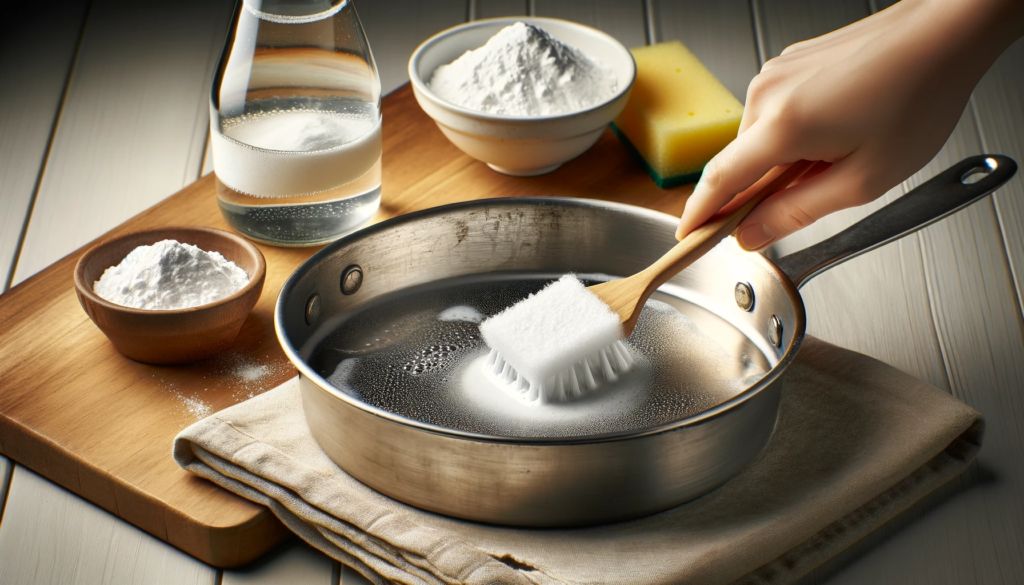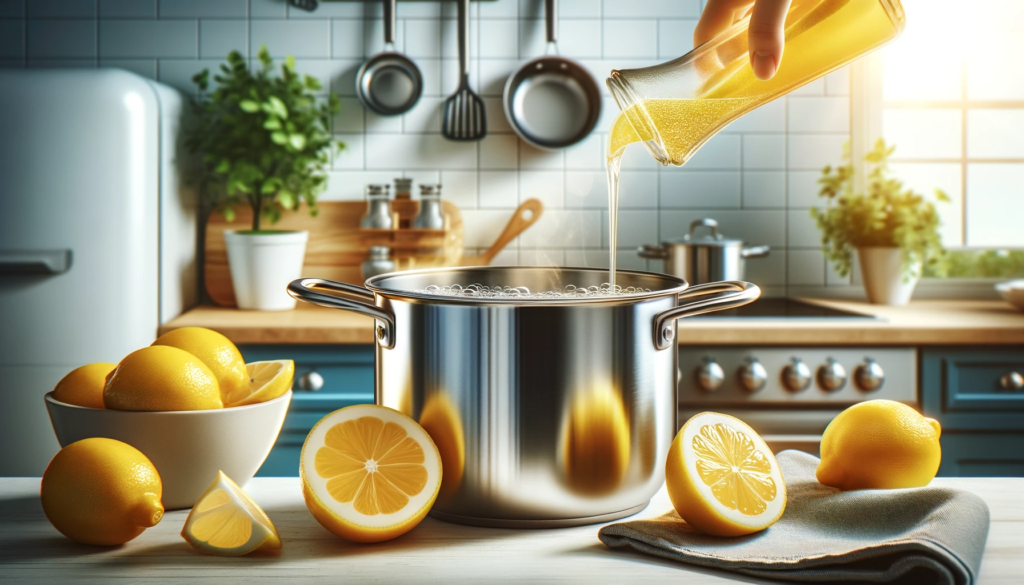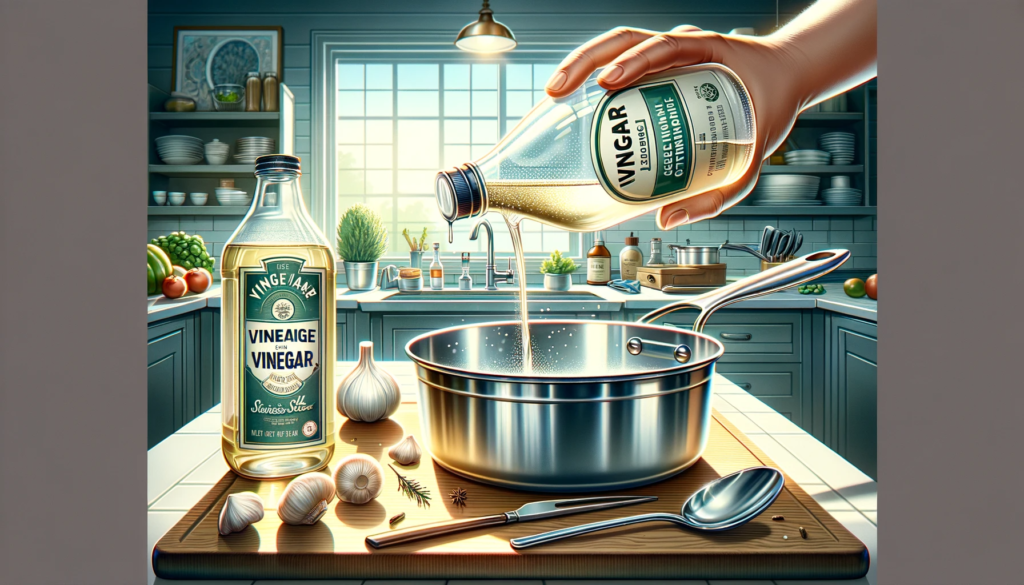That unpleasant smell wafting from your stainless steel pan can ruin your appetite, no matter what delicious meal you cook up.
While stainless steel does not absorb odors like other materials, food debris and residue gets stuck then rots and smells terrible over time.
Let’s dive into homemade solutions for removing nasty odors from stainless steel pots and pans easily using common household ingredients.
How To Remove Odors from Stainless Steel Cookware
Stainless steel cookware is popular because it’s durable, non-reactive, and easy to clean.
However, even stainless steel can absorb strong food odors and retain smells over time with ongoing use.
Getting these scents out can seem tricky, but have no fear.
There are several effective methods using common household ingredients that can get your pots and pans smelling fresh again.
Use Baking Soda

Baking soda is mildly alkaline and works as a natural odor neutralizer and absorbent.
This makes it excellent for removing odors from stainless steel pans.
There are a couple of ways you can tackle odor removal with baking soda.
One way is to simply sprinkle a generous amount of baking soda into the smelly pan.
Add enough water to make a thick paste, then use a sponge or soft cloth to scrub the paste thoroughly over the interior surface of the pan.
Make sure to scrub into crevices and along the sides.
The baking soda paste will work to lift out fatty residue and stuck on grime that may be causing odors.
Let the paste sit for at least 10 to 15 minutes before rinsing clean with warm water.
For tougher odors you can also let the paste sit overnight before scrubbing again and rinsing the next day.
The longer the baking soda can absorb, the better it will work to cut through stubborn smells.
Another option is to fill your pan with warm water and add approximately 1/4 cup of baking soda.
Let the pan soak for an hour or so before scrubbing and rinsing clean.
The water activates the baking soda so it can penetrate and neutralize odors more effectively.
The grime causing smells will be lifted away, leaving you with odor-free cookware.
Baking soda is gentle enough that it can be used on all finishes of stainless steel.
It tackles odor removal in a safe yet effective way, making it one of the best home remedies to eradicate smells from pans and pots.
Its bacteria fighting properties also disinfect even as it deodorizes.
Try Lemon Juice

Citrus is naturally cleansing and boasts fresh, uplifting aromas that can override unpleasant smells lingering in your stainless steel pots and pans.
Lemon juice in particular works well to remove odors and leave cookware fresh smelling rather than odorless.
Not only that, but it’s an inexpensive and biodegradable cleaner you may already have in your kitchen!
For badly stained pans with burnt on residue, start by bringing water to a boil and allowing the pan to simmer for 10 minutes or so to soften stuck on gunk.
Drain and wipe out any loosened bits before proceeding.
To use lemon juice for odor removal in stainless steel pans, pour approximately 1/2 cup directly into the pan and swirl to coat all interior surfaces up the sides.
You’ll likely hear the juice fizzing as it reacts with grime in the pan.
Allow the lemon juice to sit for at least 5 minutes before scrubbing with a soft sponge or cloth.
You can work the food-stained and rust-stained pan hard to remove debris, then rinse very thoroughly with clean water.
Buff dry with a soft towel.
When using stain removers, cleaning pastes or abrasive scrub pads, scrub gently and only use stainless steel specific products to avoid wear and tear to the finish.
Harsh scrubbing can lead to small scratching that further traps dirt and smells over time with use.
As a preventative measure or for maintenance cleaning, spritz your stainless steel cookware with lemon juice mixed 1:1 with water.
Let it sit before wiping out over time to keep your pots and pans fresh.
The citric acid cuts through grease and residue, while the aroma eliminates odors rather than simply masking smells.
Plus, your kitchen will smell amazing!
Aside from lifting stains, eliminating smells, and disinfecting pans, lemon juice leaves behind a shiny, streak-free look.
It works to naturally polish stainless steel through its cleansing citric and ascorbic acids.
Your cookware will look refreshed and renewed.
Use Vinegar

Like lemon juice, vinegars contains acidic properties that work to dissolve alkaline compounds that lead to grime build up and odor retention in stainless steel cookware.
White vinegar or apple cider vinegar are best because the pigment won’t stain.
But you can also use other light vinegars including rice wine or red wine vinegar.
Start by pouring approximately 1 cup of the vinegar of choice into smelly pans and pots.
Swirl the vinegar all around to coat all interior surfaces evenly.
Place a lid on top, if possible allowing the vinegar to soak and penetrate for at least an hour or overnight for severely smelly and stained pans.
This gives the acetic acid time to work dissolving grime and releasing trapped odors.
After adequate soak time, use a soft sponge to gently scrub away loosened residue.
Use a toothbrush to get into corners and along rivets where gunk hides.
Rinse very thoroughly with clean, ideally distilled water which won’t spot.
Vinegar residue left behind can lead to water spots over time or brown burn marks if pans get heated before the vinegar is sufficiently rinsed away.
The longer you can allow vinegar to penetrate, the better luck you’ll have banishing persistent foul odors from cookware.
For maintenance, wipe pans with diluted vinegar after washing or before storing.
You can also occasionally simmer water mixed with 1/2 cup vinegar for 10 minutes to freshen pans—just be sure to rinse well after.
The cleansing acetic acid in vinegar tackles unwanted odors and prevents their return with regular use.
An extra tip when dealing with extremely smelly cookware is to simmer vinegar-water solution for 10 minutes before sealing the pot with plastic wrap.
Allow it to sit overnight giving off gas that works to loosen stuck on residue for scrubbing away the next morning.
This gas treatment can be really helpful for eliminating lingering odors that other methods cannot tackle alone.
As a bonus, using vinegar helps restore the brilliant stainless steel shine through removing mineral deposits and water spots.
It cuts through grease buildup, so pans look freshly scrubbed after an effective vinegar soak and wash.
Vinegar aids lemon juice with safe, biodegradable stainless steel cleaning to renew cookware’s appearance along with banishing undesirable odors.
Clean with Baking Soda and Dish Soap
Using plain water and a soft sponge may work well for light surface cleaning of stainless steel pans and pots.
But sometimes you need a little extra elbow grease when dealing with set-in stains, burnt-on food, or lingering odors that water alone cannot conquer.
That’s where combining the odor fighting power of baking soda and the grease cutting ability of dish soap comes in very handy.
To make this versatile stainless steel cleaner at home, simply mix approximately 1/4 cup baking soda with about 1 tbsp of dish soap—liquid dish soap works best.
Slowly blend in hot water a little at a time until a smooth, spreadable scrub paste forms.
The texture should be thick yet fluid enough to easily apply to vertical pan surfaces.
Add a little lemon juice for extra odor fighting power and brightness if desired.
Before applying the cleaner, fill the pan with very hot water to open pores and soften debris.
Allow to soak 5 minutes before draining and wiping away any loose residue.
Apply a thick layer of the DIY scrub paste and use a soft brush or sponge cloth to distribute evenly, forcing it into recesses on the interior.
Make sure to thoroughly coat the sides, corners, bottom and undersides of handles.
Allow the paste to penetrate for 10-15 minutes before scrubbing again.
Use a soft toothbrush to loosen stuck on bits in crevices and rivets.
Rinse clean using the hottest water possible for your hands.
Repeat applications if needed for extremely dirty and smelly pans.
This baking soda and soap paste both removes grime to eliminate odors and deodorizes as it cleans thanks the natural absorbent properties of baking soda combined with the grease cutting ability of dish soap.
Besides being highly effective at removing odors and stains from stainless steel, this paste cleaner has the advantage of using only natural ingredients that are biodegradable and safe for the environment as well as your skin.
Baking soda is a very gentle abrasive alternative compared to harsh scouring powders, while dish soap like Dawn contains no phosphates or ammonia that pollute waterways.
For stainless steel pots with burnt on oil spots, allow paste to set on stains over several hours or overnight before scrubbing and rinsing away.
This extended dwell time gives the active ingredients more opportunity to penetrate and lift stains.
You may need to repeat for extremely stubborn spots, but the baking soda/dish soap duo works very effectively to clean while naturally deodorizing smelly cookware.
Conclusion
Stainless steel cookware is meant to last, but odors can build up over time dulling its shine.
Rather than replacing expensive pots and pans, revive them using natural ingredients likely already in your kitchen.
With a little scrubbing effort, baking soda, lemon, and vinegar tackle odor removal safely and economically so your cookware smells fresh for all recipes to come.



